In 1908, Ole Krag (the same man associated with the Krag-Jorgensen rifle) applied for a US patent on an automatic pistol design. This design, along with many others, would be submitted to the Norwegian military pistol trials taking place around that time, and would fail to in them (the winner was the Norwegian copy of the Browning 1911, which was adopted as the M1914). Krag’s pistols never did go into serial production at the time, although he made quite a variety of prototypes. Here are a few of them:
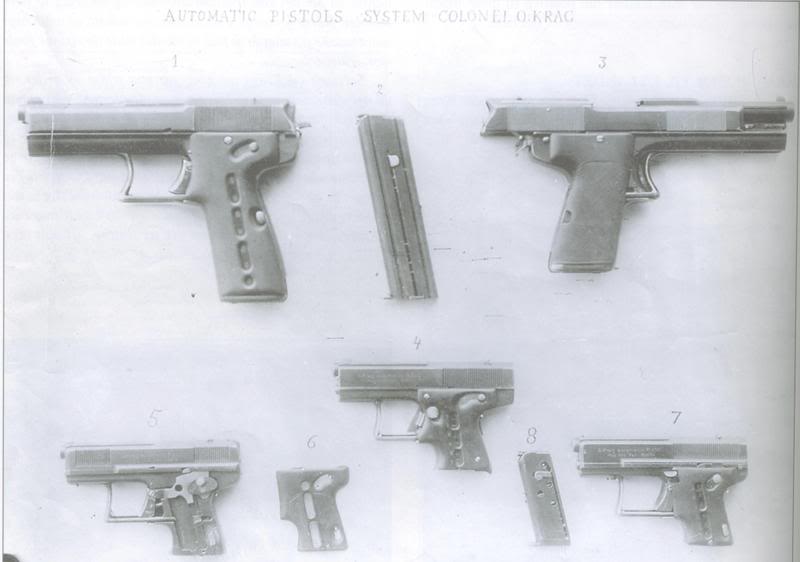
One feature that immediately jumped out at me when I saw this photo was the use of the front of the trigger guard to rack the slide of the gun. Ever since I found myself a JoLoAr I’ve been interested in guns with that functionality. Well, when I dug up a copy of Krag’s US patent (#954,441) I found two surprises.
First, Krag put more thought and effort into single-handed operation than the other such designs that exist (like the Lignose Einhand). He was specifically incorporating the feature to simplify use of his pistol as a single-loader, which was a popular idea with many military forces at the time. One will notice magazine cutoffs on a great many service rifles from before WWI, and it was not an unknown feature on autoloading handguns as well (the Webley 1913, for example, had a second magazine catch to keep the ammunition from feeding). The Krag design did not have a way to hold a magazine in reserve, but it was intended to be as fast as possible to the shooter to use with single rounds after emptying the magazine. By requiring only one hand to both hold the gun and operate the slide, the other hand could be used to supply single cartridges quickly and easily. To supplement this, Krag incorporated a mechanism into the gun so that when the slide had locked open on an empty magazine, pulling the trigger would depress the magazine follower, thus allowing the slide to close. A second trigger pull would then fire the chambered round, which would cause the slide to lock open again.
All in all, a clever (if overly complex) solution to a problem that really was better addressed by providing more magazines to the shooter. But it was 1910 or so, and we will forgive Krag for not recognizing that (interestingly, the Krag-Jorgensen rifle is also unusually well-suited to loading single rounds). The other surprise I found in the patent is a bit perplexing. Here is the initial diagram included in the patent. Note that there appears to be a very clear hole in the bottom of the barrel, just ahead of the chamber:
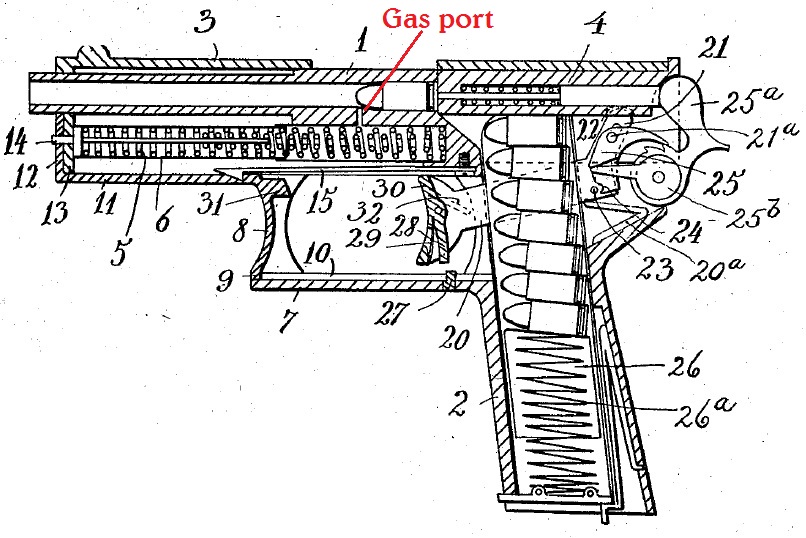
Now, Krag’s patent description makes no mention of this gas port whatsoever. He only gives the actual operating mechanism of the gun a single sentence, which basically says that recoil energy pushes the slide back, as is well understood in pistol design (blowback operation). However, when I saw that port alongside the trigger guard racking mechanism, I immediately thought of the Norinco M77B. Released in the early 1990s and only imported into the US in small numbers before Norinco imports were restricted, it has both of these same features. Could it be that someone in Norinco stumbled on Krag’s patent and decided it would be a good gun to put into production?
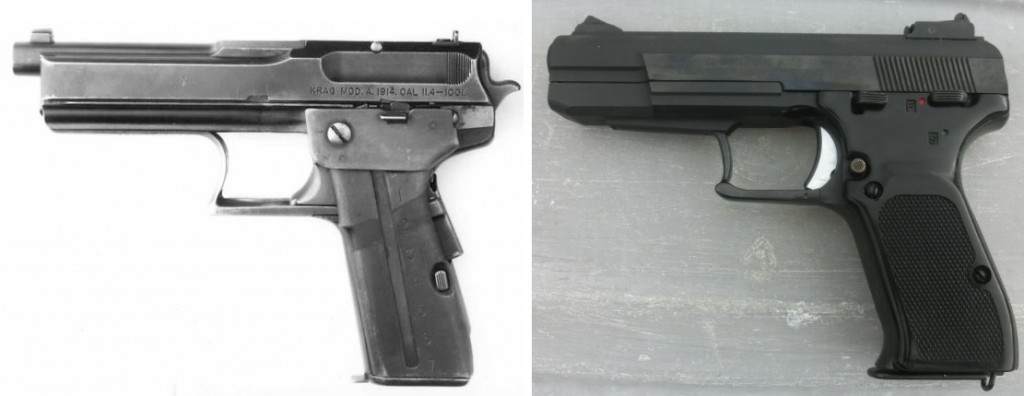
There are a few obvious differences – the magazine release (heel for the Krag; button for the Norinco), the Krag hammer being changes to a Norinco striker, and the Norinco safety lever for example. But these are relatively superficial, and it seems like a rather unlikely coincidence that both guns would share the relatively unusual gas-delayed blowback operating mechanism and the very unusual trigger-guard-cocking device.
Since I don’t have any photo of the internals of any of Krag’s experimental pistols, the next best thing I can do is provide a bunch of photos of the inside of the M77B. If Norinco did indeed use Krag’s patent as the basis for the M77B, they did make some rational modifications to it. Most notably, the Norinco is devoid of all the extra pieces to allow a trigger pull to depress the follower and close the slide. Instead, the M77B has a very typical modern slide release lever ahead of the safety.
Since it uses a fixed barrel, disassembly of the Norinco is simple. Rotate the safety lever so it is pointing straight down (there is no marking for this position), and then pull the slide all the way back and lift it upwards off the frame. The gas-delay system is then immediately recognizable from the small gas piston fixed to the front of the slide. This piston rests in a cylinder fixed to the frame, which has a gas port leading into the barrel just ahead of the chamber. When the gun fires, high-pressure gas fills that chamber, pushing the piston forward. That forward force acts against the rearward force that would normally operate a blowback pistol, and keeps the slide safely closed until the bullet leaves the barrel and pressure levels drop. The same basic mechanism is used in the H&K P7 series, and a few other less common pistols (it was also the mechanism used in the German VG1-5 rifle). I would be very interested to see inside Krag’s actual prototypes to see if they use this system, or if these features in the patent drawing were abandoned for some other system.





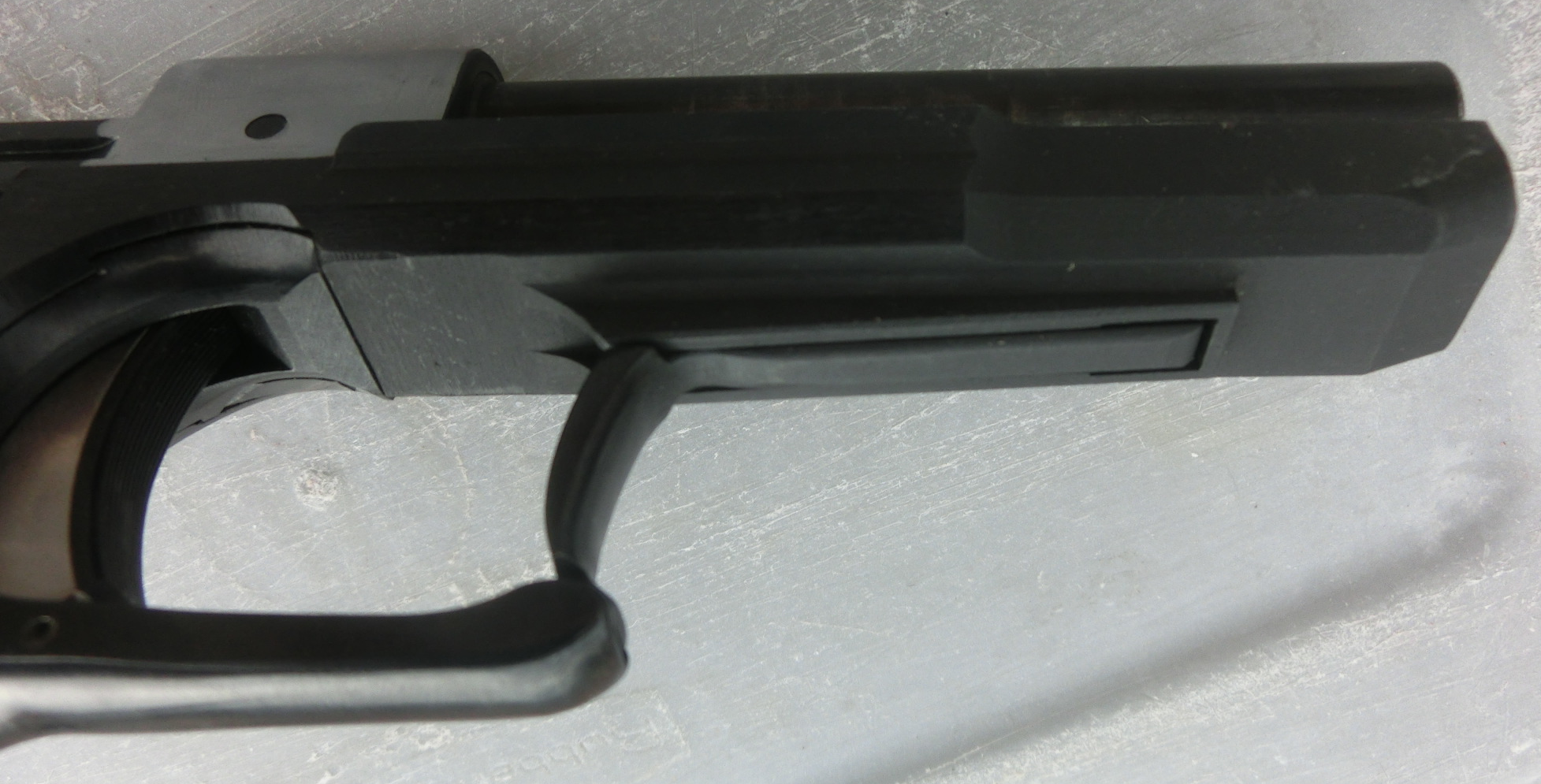




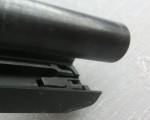

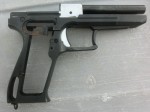
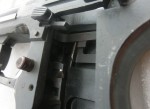

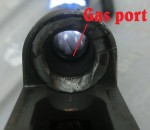
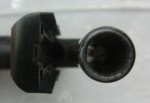
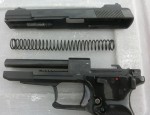



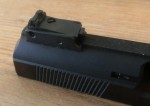
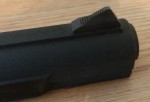



Interesting to see the comparison to the m77b. One small correction though: the M1911 was adopted as the Mo 1912. The Krag pistol is the one that’s designated “1914”. You can see it stamped on the slide in the comparison picture.
According to Ezell’s Small Arms of the World, and the NRA’s National Firearms Museum, the Norwegian 1911 was indeed called Model 1914. It makes sense that all prototypes for trial would all have that designation.
http://www.nramuseum.org/the-museum/the-galleries/world-war-i-and-firearms-innovation/case-57-world-war-i-allies-the-world-at-war,-1914-1918/norwegian-model-1914-pistol.aspx
It appears you are correct. The reason for my confusion is that the first batch of pistols had M/1912 stamped on the slide. This batch was made 1916-17. Why do it the easy way when you can do it the fun way. Source: Kongsberg vaapenhistorisk forening
http://www.kvf.no/vaapen.php?type=Pistol&weaponid=PIST0011
“Note that there appears to be a very clear hole in the bottom of the barrel, just ahead of the chamber”
For me this is very bad idea. If this hole exist the hot gases heated the spring, with the early 20th century metallurgy this must caused even more problems that it would in our time. And also we can’t forget about the gas fouling – in the early 20 century the smokeless powder was corrosive. Imagine that you must clean spring every time when you clean barrel.
“All in all, a clever (if overly complex) solution to a problem that really was better addressed by providing more magazines to the shooter”
Note that Krag pistol has at least removable magazine when for example Steyr-Hahn 1912 has fixed magazine. In times when many armies required rifles with magazine cutoff to able single shot the idea of multiple magazines for single firearm was probably considered as a absurd. For example they Steyr 1908 also features single-shot mode:
http://unblinkingeye.com/Guns/08Steyr/08steyr.html
The tip-up barrel feature making hand-chambering possible can be also found in some modern pocket pistols like Beretta 21A Bobcat
It’s noteworthy that later gas-operated or gas-retarded blowback pistols generally put the gas takeoff near the muzzle, as on the Italian Scotti prototype of the 1930s, the Steyr GB series, and the Desert Eagle. However, the Krag arrangement resurfaced in the Karl Gustav gas-operated prototypes of the early 1970s, with the gas port right in front of the chamber.
This may have been intended to compensate for poor quality control on ammunition (endemic to the WW I era) by ensuring that the gas system received the maximum possible pressure.
To judge by the slide inscription on #2675, it’s probably chambered for .45 ACP or .455 WSL (“11.4mm”). I would suspect that with modern or even mid-century ammunition, the greater gas pressure would tend to cause either late slide opening (in the gas-retarded systems) or excessively early opening and increased slide velocity (in the gas-unlocked locked-breech arms).
The retarded-blowback GB was noted for its ability to digest hot 9 x 19mm SMG ammunition with no difficulty. I’m not so sure this design could do so, therefore chambering it for the lower-pressured big-bore rounds makes excellent sense from a safety and durability standpoint.
cheers
eon
Do you why GB was discontinued? Was is due to extensive maintenance requirement? I liked the structure of it; it looked like extensively investment cast.
I just watched a vid on YouTube about the GB – evidently it was produced by a company here in the US without the approval of Steyr and got a bad rep for unreliability….after Steyr sold a number of the Austrian built pistols in the US (on which they took a loss) they decided to raise the price to recoup some of the costs – the sales plummeted and Steyr cut its losses and stopped producing it…BTW – the magazines, if you can find one, run around 3 – 400 bux – a bud of mine, recently deceased, at Sikorsky had one in the late 80s – we went out one day after work and shot a few magazines at an old softball…it was a pleasant gun to shoot, but after that day I only saw them occasionally at gun shows here in So. FL. Look for the Steyr GB on YouTube…you’ll find the vid I’m referencing…
CB in FL
Thank you your information Chris. We live in time of increasing uniformity and that is in many ways. When comes to firearms and pistols in particular (and we had plenty of proof on this page), many attractive designs were abandoned in favour of what became mainstream.
In particular, when looking at GB design, it may be superior by simplicity of construction and by the fact its barrel is stationary and therefore conducive to accuracy. No added wiggle, no complexity. And yet, as we see, against all of logic… no marked success. Kind of disappointing.
“And yet, as we see, against all of logic… no marked success. Kind of disappointing.”
This is very simple reason: Americans don’t reads the manuals. According to: http://en.wikipedia.org/wiki/Steyr_GB the Steyr GB works properly with fast burning powder, but users tends to use slow-burning powder believing that will make pistol more reliable but it did inversely.
Wikipedia text is somewhat confused and exegerated. The pistol subject to decpiption is American “Rogak” which being a member of “Basic Blowback” naturally liking fast burning powders and was the cause of its prematured failure along with its bad workmanship. Steyr GB manual contains no warning about any kind of powder type of cartridge to be used and if it were, it would be an advanced acceptance of unsuccessfullness for a service pistol. By the way, GB frame is formed by presswork and investment cast application for main parts is none.
In the early 20th century a whole bunch of mechanisms were invented to do pocket pistol safe to carrying and being ready to shot as fast as possible. This was needed to compete with double-action revolvers. From very complex to very simple like for example special-shaped slide of Praga Model 1921 pistol:
http://forum.valka.cz/viewtopic.php/t/112091
Kind of funny creature… I presume you grasp term “bambitka”.
That hole in front of the chamber reminds me of the H&K P7 gas-delayed blowback operation.
What worries me about the trigger-guard slide racking function is: What if the guard somehow gets stuck to the working parts? Instead of staying in place when the gun cycles, it then bashes your trigger finger. Maybe even inadvertently goes full-auto. (Yeah, I know, “It can’t happen.” In field conditions, uncleaned, abused…)
On the Norinco, at least, the trigger guard lever can’t inadvertently cycle, because it is in front of the catch on the slide. Basically, it’s a non-reciprocating charging handle, and there is no way for the slide to grab it.
If you look at the one numbered 2689, its frontstrap looks suspiciously P7-like, as well. I suspect it had a frontstrap grip safety, similar to that of the Schwarzlose 1908 9 x 17mm (.380 ACP) blow-forward pocket pistol, which according to Jan Stevenson was chiefly memorable for its formidable recoil.
cheers
eon
I guess the reason for Einhand (one handed racking and cocking) pistols is that in a horse-bourne world, the rider needed a hand on the reins.
Rumor (which I can’t substantiate) has it that the JoLoAr was inspired by a Spanish Foreign Legion officer who lost an arm in combat…
Horseback operations were certainly considered when designing full-bore service pistols, but the reason for the Einhand pocket pistols was rather different.
Many people back then did not trust safeties (with good reason), and were wary of carrying a self-loading pistol with a live round in the chamber. The Einhand system allowed a Condition Three carry (loaded magazine, empty chamber) while allowing the user to quietly cycle the action to load in the pocket in time of need. Thus retaining the element of surprise vs. an assailant.
Also, in event of a dud round in the IA, a sharp pull on the “hook” made a tap-rack-BANG drill very easy, even for an untrained user.
cheers
eon
HO-LEE Crap!!! I remember seeing that Norinco pistol at gun shows here in South Florida…the trigger guard slide racker you mentioned zapped my memory cells….I wish I’d paid more attention to it, but at the time I was paying on my custom Springfield Armory 1911 (1911s like the one I had made now come from the factory with most of the mods I ordered)…soon’s I saw the gas port in the barrel I thought of the H&K P7 series…mebbe one day I’ll see someone desperate to unload (no pun intended) that little Norinco and be able to glom it for pennies on his dollar. Around the same time as this pistol appeared, Daewoo introduced what they called the “Tri-action or Triple Action pistol…basically it was a DA 9mm with the added features of the Safety Fast Shooting System adapted by Cylinder & Slide from the Browning (FN Herstal) developed method of safing the action my pushing the hammer forward into a ‘half-cock’ position and bringing into action by sweeping the safety upon presentation, resulting in a lighter trigger pull….buncha other weird stuff showed up around that time also…Thanx, Ian for all this research & work!!!
the gas port may have been somebody elses pattent wich is why it isnt mentioned in the krag patent .
i cant even wrap my mind around the whole “trigger gaurd works the slide” thing. funky.
Actually IIRC it was kinda ungainly (or funky, as you said)…you had to change your grip to get your finger around the front of the trigger guard which was the actuator for racking the slide…kinda an answer in search of a question no one asked…I remember ‘playin” with one at a show (or shows) here in South Florida in the early 90s or so and tryin’, even back then, to figger out why it was spozed’ta be a good idea…I’m sure there was an lockout system that prevented you from accidentally pulling the trigger if your finger slipped off the trigger guard as you were actuating the slide, but I really don’t remember…perhaps not and that was the reason it never caught on…I have no idea…but again, Ian, thanx for bringing this up…I’d completely forgotten about it (I wonder why???)…Sometimes you WONDER why a certain weapon was forgotten and at other times you KNOW why the design was forgotten…
CB in FL
I remember those Norinco M77’s well. I only ever saw one at a gunshow in Sacramento, and at the time, I wasn’t old enough to purchase it. I always thought that the novelty of it’s action would place it in some B-rate Hollywood action movie but I’ve yet to see one on screen.
Just because you said that, some talentless, aspiring writer will see this and construct yet another implausible action flick based around this “New” semi-automatic…
CB in FL
Ian,
Check out this Val A. Browning patent 2,921,503. Another one-hand cocker.
Emery K.
The mechanism used in Einhand pistol is a patent of Witold Chylewski – Patent US1224902
http://www.google.com/patents/US1224902
These are very interesting and equally important findings that will change the common acceptance of “Gas Brake” or “Gas retard” and “One Hand Cocking” inventions. However, registering the same approach of “One Hand Slide Actuating Via Trigger Guard” within the life of a prepubished patent by the USPTO is also interesting and mind confusing. This also reveals that there should be an undiscovered US patent for “Gas Retard Action” before the date of Krag’s related publishment. Thanks for Ian for these remarkable findings.
I have a norinco 77B and have always found it to be a reliable and accurate shooting pistol. Thanks for the article.
I can only hope, Chris Brosnahan.
My old man was given (his story) a Norwegian 1914 by a Fort Lee, NJ (yeah…before the entire state turned Communist) cop back in the early 60s…unfortunately he sold it before he moved here to Florida in 1979, thinking erroneously, that FL gun laws were WORSE than those of NJ…I’ve seen those 1914s selling for upward of $1500 in some cases (his was a particularly pristine example)
CB in FL
I knew I’d seen this design before.
It’s the Walther CCP debuted in 2014 !
Edited below .
I knew I’d seen this recoil design before.
It’s the Walther CCP debuted in 2014 !
Common data is provided as well as comprehensive information-such
whilst the regular taxi ticket from your airport
for the selected area.
Comments to an old post.
I actually owned one back in the day.
Very neat piece. I do recall it was a pain in the a$$ to operate the mechanism with the trigger guard. As I recall it almost took both hands (right & left forefingers) to cock it. This in time the novelty wore off quickly and prompted me to sell.
If only I had a nickel for all the cool guns I’ve sold over the years. I might have $50
Hello Ian,
Have you thought about making a video about “Prestige Weapons” like the swords carried by WW1 officers or the AKS-74U carried by Osama bin Laden?
This ties in with your “Warlords” book and broom handle Mausers carried by Chinese officers.
I am referring to weapons worn as badges of rank on the battle field … not the gold-plated Kalashnikovs favored by showy, tin pot dictators like Saddam Hussein.